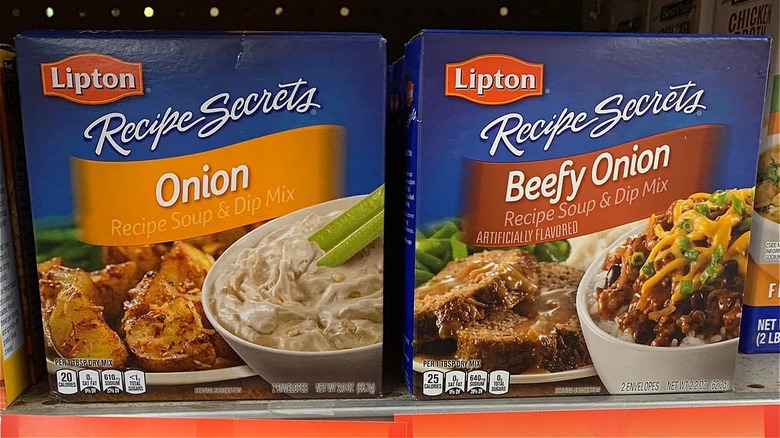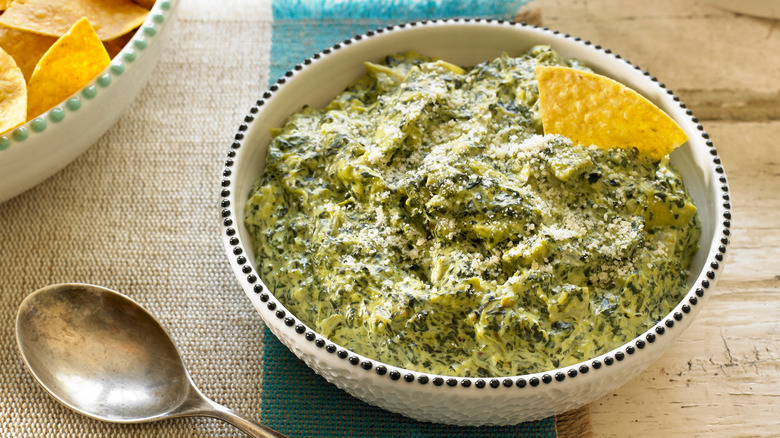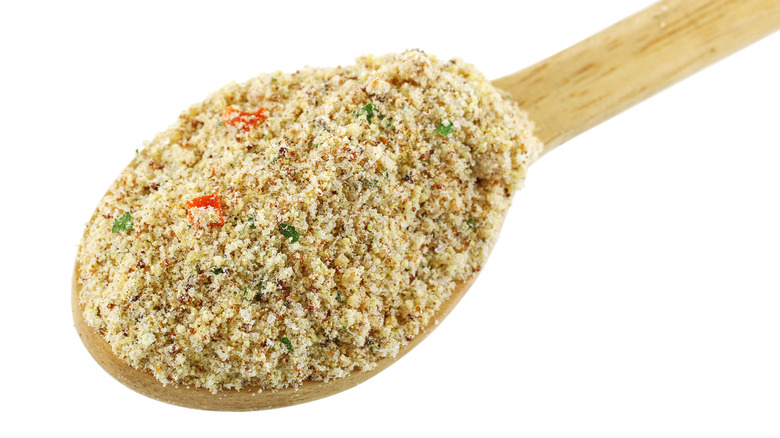Why Dried Soup Mix Is The Seasoning You Didn't Know You Needed
Just about everyone reading this would have either heard of or tasted Lipton Onion Soup, but few, if any, will probably recall ever having consumed it the way its inventors might have intended. Made with onion flakes and onion powder, certainly, but also salt, sugar, cornstarch, soy sauce, caramel color, maltodextrin, corn syrup, and yeast extract among other things, the packet was introduced to the American consumer market in 1952, when Wide Open Eats says convenience foods were being picked up by the average American consumer. Even then, Food52 says it took two years before it was blended into sour cream to create one of the most iconic food pairings of the 20th century in a creation that would come to be known as California dip.
Dip wasn't the only dish the dried soup was used for. Lucky Peach writer Ashley Goldsmith reveals that Lipton Onion Soup was a favorite among Jewish American cooks, who blended it into everything from brisket to stuffed cabbage because it was a tasty additive — and it was convenient. It could even be a modern update to French onion soup. "I actually do really like the taste of it too. It's also one less thing that I have to do while cooking," Goldsmith's grandmother told her. "[Besides] You never just make brisket. You also make a lot of other things to go with it, so if I can just take a package and throw it in there then it'll save me some time and some pots and pans."
Some people pulled away from using dried soups for a while
Lipton wasn't the only company making dried soups. In fact, a German food experimenter named Carl Heinrich Knorr had been playing with the idea of drying vegetables and seasonings, and it was not long before the first Knorr soups were introduced to the European market in 1873. Today, Knorr's dried vegetable recipe packet is a key ingredient in the making of the company's recommended hot spinach and artichoke dip. The powdered mix contains a dried vegetable medley including carrots, onions, tomatoes, cabbage, and cauliflower.
Why dried soups might have fallen from popular culinary grace — at least for period of time — can be seen in one Chowhound chain, where users exchange recipe ideas using dried soup packets. However, one user ultimately wrote, "You're probably going to hate this post.... Just be sure you look at the ingredients list. [The first] ingredient is potato starch, second is MSG. I quit reading there and pitched it."
While it's unclear if this is actually the reason why people stopped using these packets for a time, it's interesting to consider, and it's at least why one person stopped using them altogether.
Dried soup packets are making a comeback
But just as MSG got a second look thanks to the endorsements of chefs like Momofuku founder David Chang and Heston Blumenthal, per The Manual, dry soup packets may be making their way back into pantries across the country. In fact, In 2018, 58 million packets of Lipton's dried onion soup were sold, as noted by Food52.
While they may not use dried soup packets in their restaurants, some chefs have come forward to say they lean into them at home. "I have always found a huge amount of joy in channeling some of their qualities with soup flavor packets: ingredients that are engineered to make water taste like dinner," Chef Tyler Kord wrote in Taste. "I will often make my own broths to cook instant ramen noodles in and save the flavor packets to season vegetable stews, pork chops, or really anything that wants a little extra umami—when used with a light touch, they can have an amazing effect."
Other chefs agree. "Yes, natural is good and healthy, and whole foods are important," Momofuku's David Chang wrote in Wired. "However, experimentation is important too. Once you realize that cooking is a science, you realize that it's the only science in which innovation is frowned upon—where there are powerful efforts to stifle and stall innovation. It doesn't have to be that way. Instead, let's celebrate the kitchens, labs, and people who are creating foods and tastes that we've never experienced before."
Ultimately, these soup mixes are on the market for a reason, so why not try utilizing them next time you want to prepare a French onion soup recipe?


